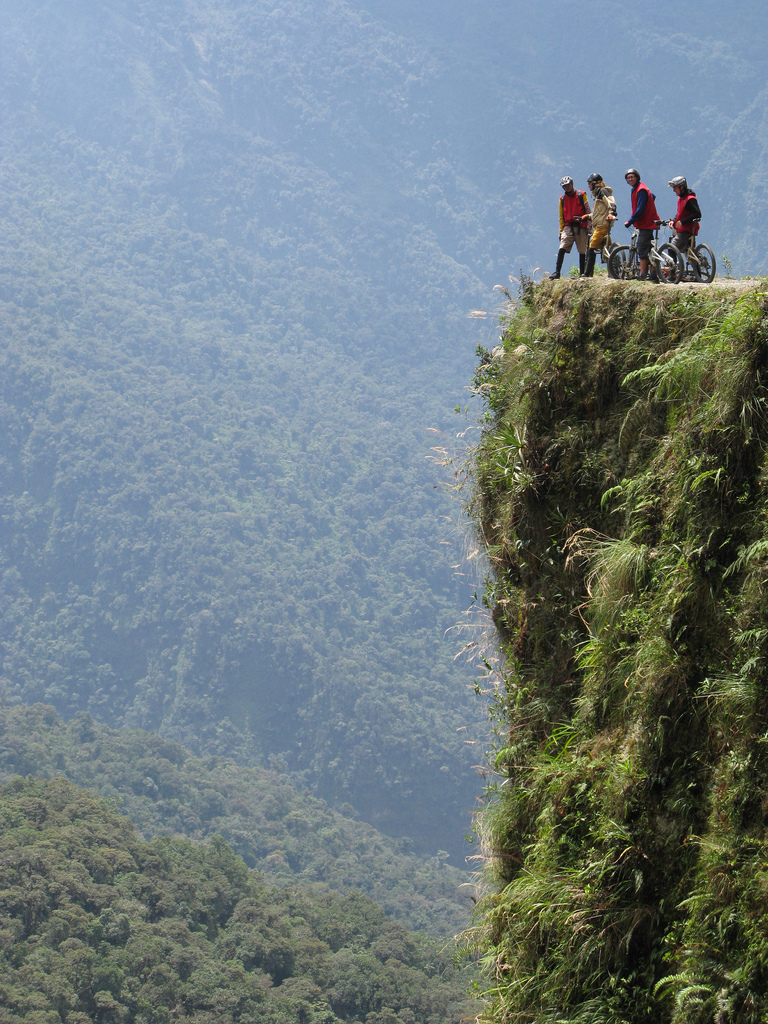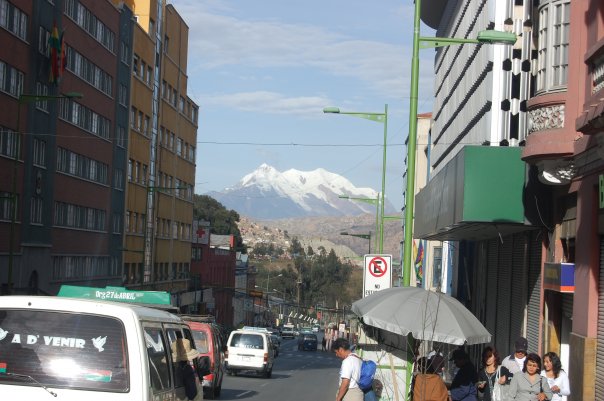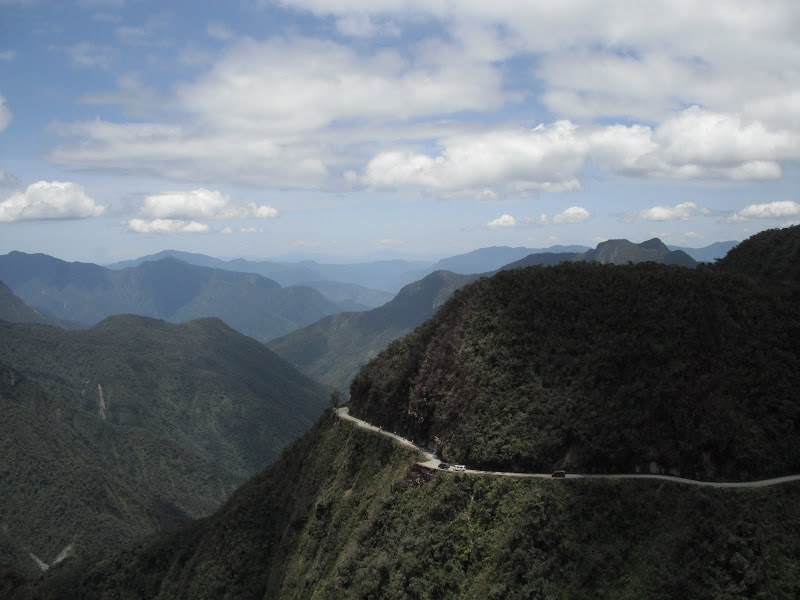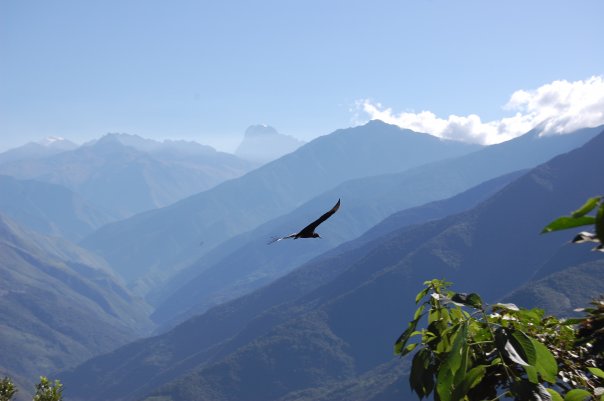The Best Day Out Cycling Death Road in Bolivia
Last Updated on January 12, 2024 by Adam Watts
Death Road in Bolivia is one of the most dangerous roads in the world, and the day we cycled down it was also the last day I’d ever see any of my traveling companies. But since this is a comedy travel writing site, I’ll try and keep it light, informative and funny.
Why is it called Death Road?
It’s not. Well, not only called that. It’s formally known as the Yungas road, but has the nickname “Road of Death” because, just between the years 1999 and 2003, hundreds of Bolivians died trying to navigate it. Since then some additional routes have opened and naturally people prefered to use a nice new road than one very likely to kill them. But the nickname stuck, and it’s catchier than “Holy Mother of God That’s a Long Way Down Road”, so I’ll be calling it Death Road for the rest of this post.
Cycling Death Road
When I visited Bolivia in 2009, cycling Death Road was perhaps not exactly the most popular thing for tourists to do, but it was certainly way at the top of our to-do lists, being 20 year old gap year backpackers with no purpose in life.
Death Road, as discussed by three middle-aged men on prime-time British TV, is something of a challenge in a car. It also happens to be incredibly fun to cycle. Quite literally the most fun I’ve ever had doing anything, in fact.
I was with a handful of other people that I’d been travelling with from Cusco, Peru, onto La Paz, Bolivia. One of them spoke respectable Spanish so we were relying on her to avoid the rest of us having to rely on wild finger-pointing and loud-talking like ignorant British tourists on the Costa.
We waited outside the hostel about 6:45am to be picked up by a minivan and driven to the start point. We were all given helmets and padded jackets, although I couldn’t see the point. If you were to fall off the edge, it was so far down that not even being inside a padded box inside a truck rammed full of bubble wrap would’ve saved you. But we did all “look the part” with helmets and bright jackets.
The first part of the cycle was the easy part – it was all downhill, all tarmac and it was still early and the road was quiet so we raced down it, although we always had to stay behind one of the guides at the front . After that part, which was maybe a solid hour of cycling, we (and there were about 25 of us altogether, from other hostels and hotels) all piled into a small cafe and had some bread and jam, bananas, juice and some coca tea for breakfast.
After that the road was entirely gravel and dirt track, wide enough for about one a half cars in most places. It was a two-way road, somehow. On one side was a sheer rock face going upwards with the occasional dainty waterfall and overhanging trees; on the other was a sheer drop, no railings, no fences. If you fell, your cries of “oooooohhhhh shiiiiiiiit” would be quickly swallowed up by the forest of trees below.
We split up into groups, each with a leader from the trip organisation – a slow team, a medium team and a fast team. The fast team was myself, a fellow Brit and a Dutchman (both of whom I was travelling with), a French guy and a German. After a while the latter two dropped back, leaving the Brits as leaders, restoring the natural order of things.

It was a painful ride. Cycling over gravel solidly for four hours is not comfortable, no matter what bike you’re using. After the first five minutes your hand gets numb and they start slipping off the handlebars. You can imagine it didn’t get easier from there. The bike seats were no better and sitting down became really uncomfortable too. But the more painful it got, the more you were able to focus on the pain rather than spend time being terrified of hitting a big stone badly and flying off the edge. Every cloud and all that.
Coca Leaves
Thankfully we did stop a few times, to flex some feeling back into fingers and to wait for the slow-pokes. On a couple of these stops, we found ourselves next to wrinkled old women standing next to huge tarpaulin sheets covered with coca leaves.
Coca is involved in the process of making cocaine (Wikipedia has details) and a lot of locals chew coca leaves during the day instead of eating/drinking because it’s basically a “superfood“. But if your definition of superfood is that it removes desire for all other food and drink, then heroin is a superfood, raw chicken is a superfood, anything that messes with your insides can be a superfood.
But when in Bolivia, do as the Bolivians do (that’s the saying right?). So I tried chewing coca leaves. The problem is, even if you haven’t experienced it, I think you can imagine the sensation: it’s literally chewing a leaf for hours. It gets real gross, real quick.
Coca tea is freaking amazing though. And no, it doesn’t get you high or anything. It just tastes nice and maybe gives you a little more energy than normal. It’s a shame it’s illegal in most places outside of Bolivia and Colombia though.
Reaching the Bottom
After several hours, we got to the bottom. After we’d settled in with some beers (perhaps another “superfood”?), Sarah said, “Wow, Adam. I’m impressed. I wasn’t expecting you to be so good at this. You’re too… intelligent,” which was as back-handed as compliments come, especially given I was always a straight-B student.
But being here in Death Road in Bolivia, far away from home, made feel like I was living life, and leading the pack cycling down the world’s most dangerous road for four hours was just another day in my current life.
After everyone had recovered, we were all taken to some hotel with incredible views over the Andes.
“I think this is what they call a perfect moment,” Aaron said, as the six of us travellers sat cosily around a table out in the sun with some condors gliding past the mountains behind us.
He did actually say that, I’m not making it up to have a nice poetic ending for this post. He said it, we all agreed, I made a mental note to remember this line for the blog post I’d write a decade later, then we clinked glasses. Then it was time to go. Back on our bikes, back up the hill.
Only joking, we drove back. On the same Death Road. The same incredibly narrow gravel track. The same steep cliffs. Except now we were trusting an old van. And it was dark. But after hours of cycling and pain and exhiliration, I was exhausted. We all were. Despite the bumpiness and the little fact of being inches away from death, we all napped in the back of the van.
Finally, to come back to the start of this post, remember I said this was the last day I ever saw my traveling companions? Well, I wasn’t lying. But they didn’t die. Just because the next day I left them to travel alone around some random towns in Bolivia and across South America. Because that’s what gap years are for.
When I cycled Death Road in Bolivia, it was 2009, and I booked in person at a local place. If you prefer a guarantee of reliable and reputable providers, check out the Death Road Viator tour below to increase your chance of survival. Note: I’ll earn a small affiliate commission at no cost to you if you click through and purchase from Viator and I also frequently use Viator for day trips and activities on my own trips and have never had a bad experience.
And if you like adventure, read more stories to scare my mother.










whoa! that sounds amazing. That said, I don’t think I’d be giving it a try, toooooooooooooo chicken me thinks 🙂
I’ve been on 2-hour mountain bike rides in parks with contrived risks and felt as if I’d been riding Triceratops through a volcano. I can’t imagine 4 hours down a gravel road. The only good thing is that I’d likely be murdered by my girlfriend about 1 hour into it, so I’d have that relief waiting for me. And yet somehow I’m still jealous…
Great Scott, what an adventure! And so articulately written for a jock.
I did this back in 2010. Absolutely amazing! Hah, loved the bit about the old women selling coca leaves.Did you really coca tea though? I couldn’t stand the stuff!!
Haha really? I genuinely loved it. Had it for breakfast every day! Admittedly I always had quite a lot of sugar with it though…